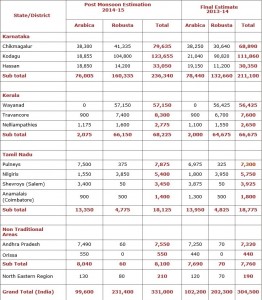In latest estimate, the Coffee Board of India revised downward its forecast for coffee production in coffee year 2014/15 by 4% to 331,000 tonnes, citing crop damage in Karnataka, Andhra Pradesh and Odisha due to continuous rain after dry spell and ‘Hud Hud’ cyclone.
At the time of carrying out assessments of crop estimation for the current year 2014-15, during post blossom stage, it was observed that the blossom showers were by and large adequate and there was a good distribution of blossom and backing showers, except in certain pockets where there was a slight delay in receipt of backing showers.
At the time of assessment of crop at post-blossom stage, an all time high of more than 3,50,000 MT was expected.
However, after the backing showers many coffee areas in Karnataka witnessed an abnormally long dry period.
Due to the prolonged dry spell, the Arabica areas witnessed heavy infestation of Coffee White Stem Borers resulting in heavy loss of Arabica plants.
Further 2014-15 being an ‘on-year’ for Robusta crop, the continuing dry spell after backing shower had a negative impact on the development of coffee berries.
Taking into consideration these factors, the post Blossom crop forecast for the year 2014-15 was estimated at 344,750 MT with the break up for Arabica and Robusta is 105,500 MT and 239,250 MT respectively.
Similar to the last year, after witnessing a long period of drought (after receiving backing showers), the coffee areas experienced continuous heavy monsoon especially in Karnataka.
The continuous showers led to soil saturation and wet feet conditions resulting in defoliation and incidences of stalk rot and black rot leading to crop losses especially in Robusta coffee in Karnataka.
The Hud-Hud cyclone of 12th October 2014 caused extensive damage to coffee plants in non-traditional areas due to large scale uprooting of shade trees leading to downward revision of crop estimates in NTAs.
While estimating the crop at post monsoon stage during Nov-Dec, these losses have been taken into account and accordingly the post Monsoon forecast for the year 2014-15 has been placed at 331,000 MT, which is a reduction of 13,750 MT (-3.99%) over the post blossom estimate of 2014-15 (click to open in a new window).
Of the total estimate of 331,000 MT, the Arabica production is estimated at 99,600 MT while that of Robusta at 231,400 MT. Arabica production estimate has shown a decline of 5,900 MT (-5.59%) while Robusta declined by 7,850 MT (-3.28%) over the post blossom estimate of 2014-15.
When compared to final estimate of 2013-14 (which was placed at 304,500 MT), the current post-monsoon estimate (2014-15) showed an overall increase of 26,500 MT (8.70%).
In terms of Arabica, the production estimate has shown a marginal decline of 2,600 MT (-2.54%), while Robusta production shown an increase of 29,100 MT (14.58%).
The increase in production estimate over the 2013-14 final estimate is mainly seen in Karnataka to the tune of 25,240 MT followed by Kerala (1,550 MT), while the Tamil Nadu has shown a marginal decline of 650 MT.
By the states, the post monsoon crop estimate for Karnataka is placed at 236,340 MT with a break up of 76,005 MT of Arabica and 160,335 MT of Robusta.
This is a decline of 11,960 MT (-4.82%) over the post-blossom estimate comprising of -5.82% decline in Arabica (4,695 MT) and -4.33% in Robusta (7,265 MT).
In Karnataka, the Kodagu district experienced a maximum decline of 9,495 MT both in Arabica (1,295 MT or -6.43%) and Robusta (8,200 MT or -7.26%) over the post blossom forecast followed by Chikmagalur (1,535 MT or -6.97%) and Hassan (930 MT or -2.74%) districts.
In Kerala, the berry development was normal and not much adverse effect on crop was reported. Therefore the post monsoon forecast is placed at 68,225 MT with a marginal decline of 650 MT (-0.94%) from the previous post blossom estimate of 68,875 MT.
In Tamil Nadu post monsoon forecast is placed at 18,125 MT against 17,875 MT of post blossom estimate which is a marginal decrease in production of 250 MT.
In Non-Traditional areas of Andhra Pradesh and Orissa the post monsoon forecast is placed at 8,100 MT against post blossom estimate of 9,480 MT with a decline of 1380 MT (-14.56%) mainly on account of Hud-Hud cyclone. In North-Eastern Region, the post monsoon forecast is placed at 220 MT.

















